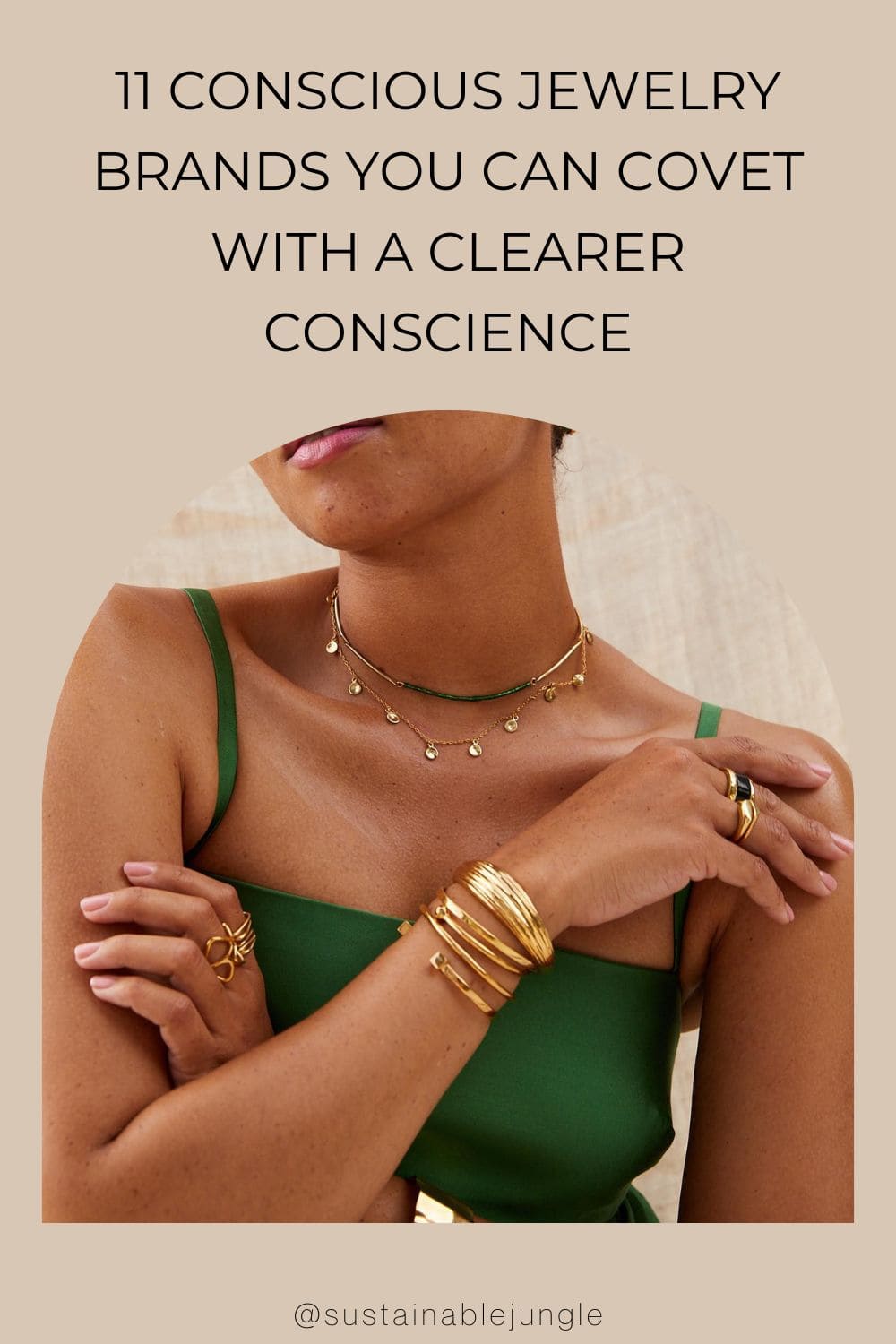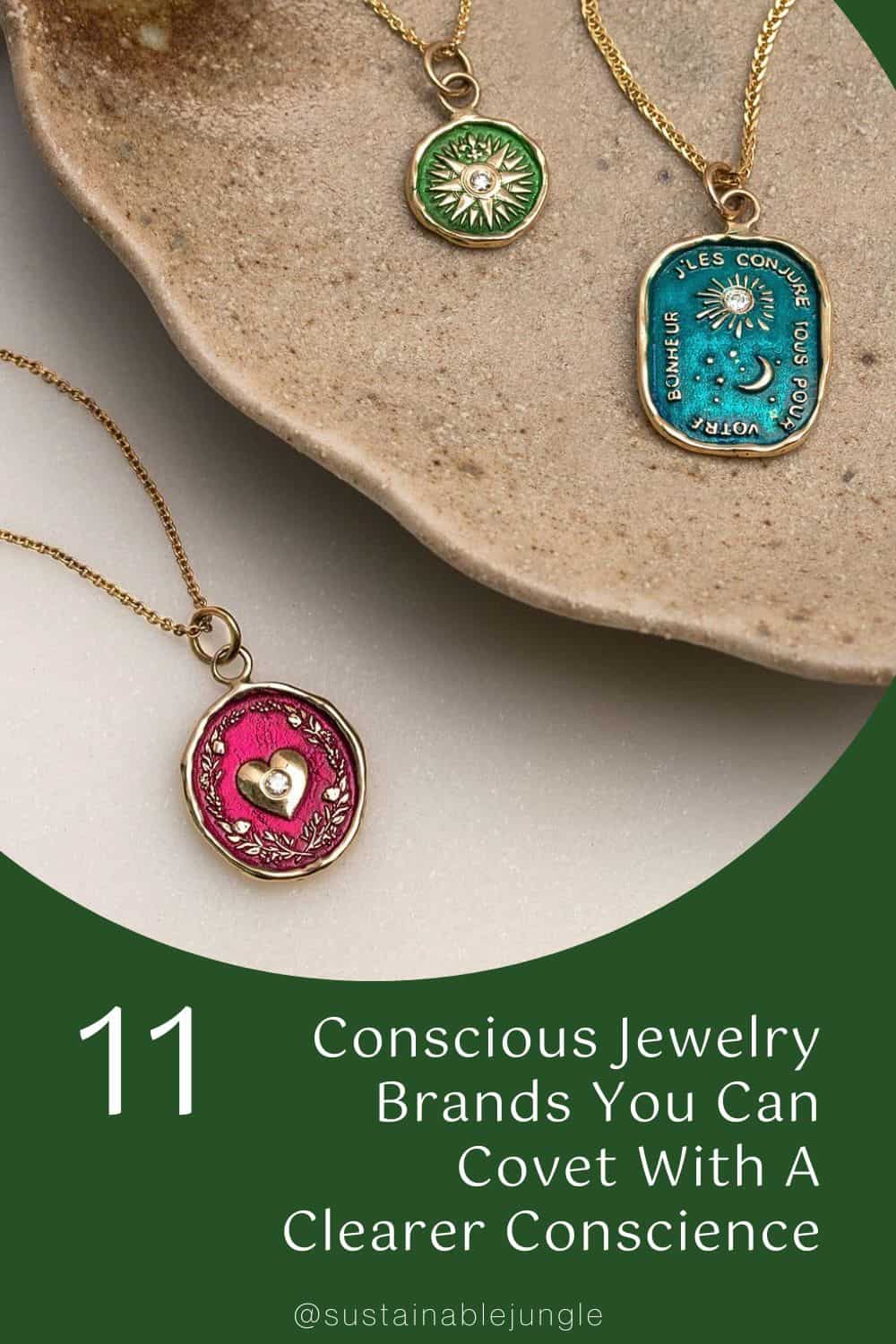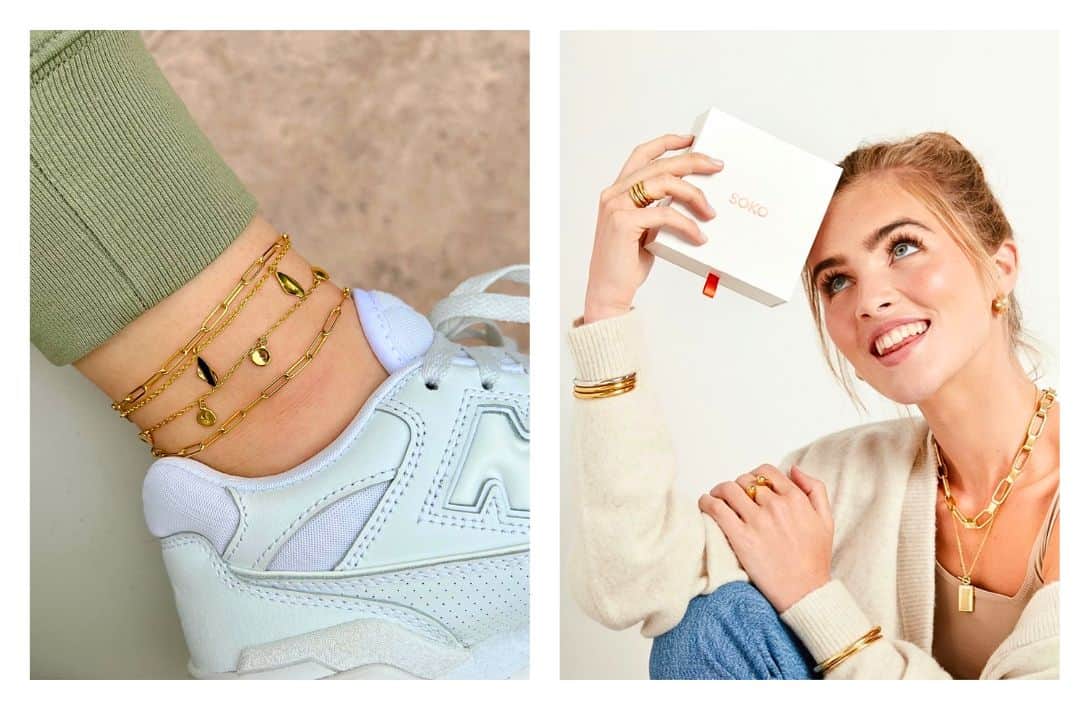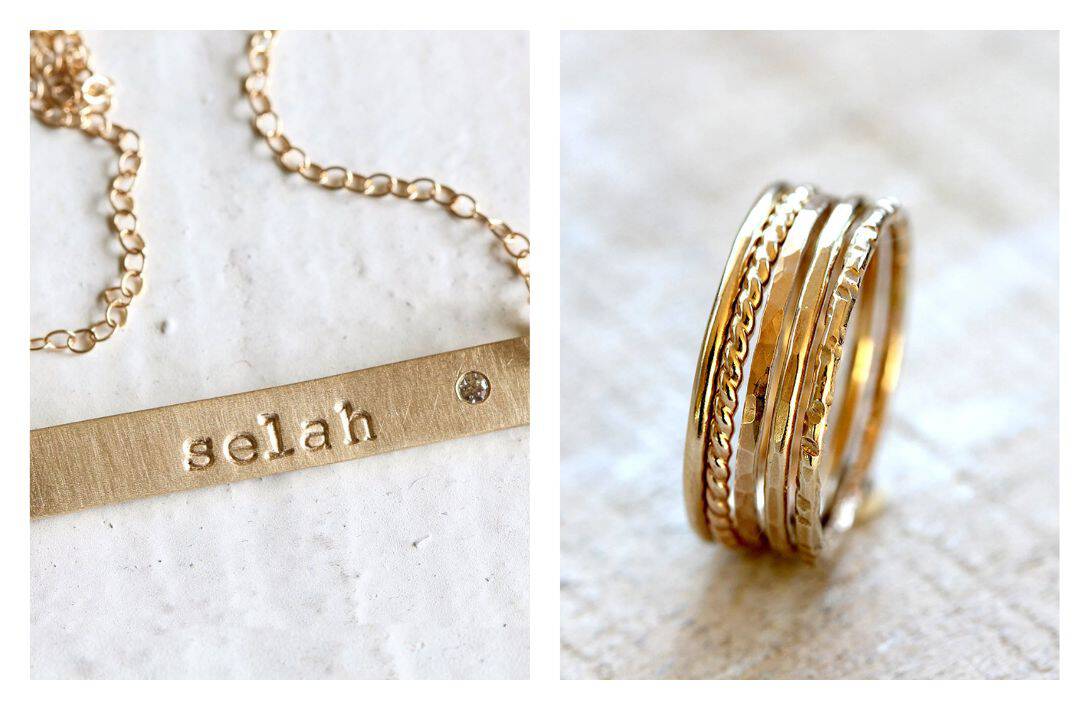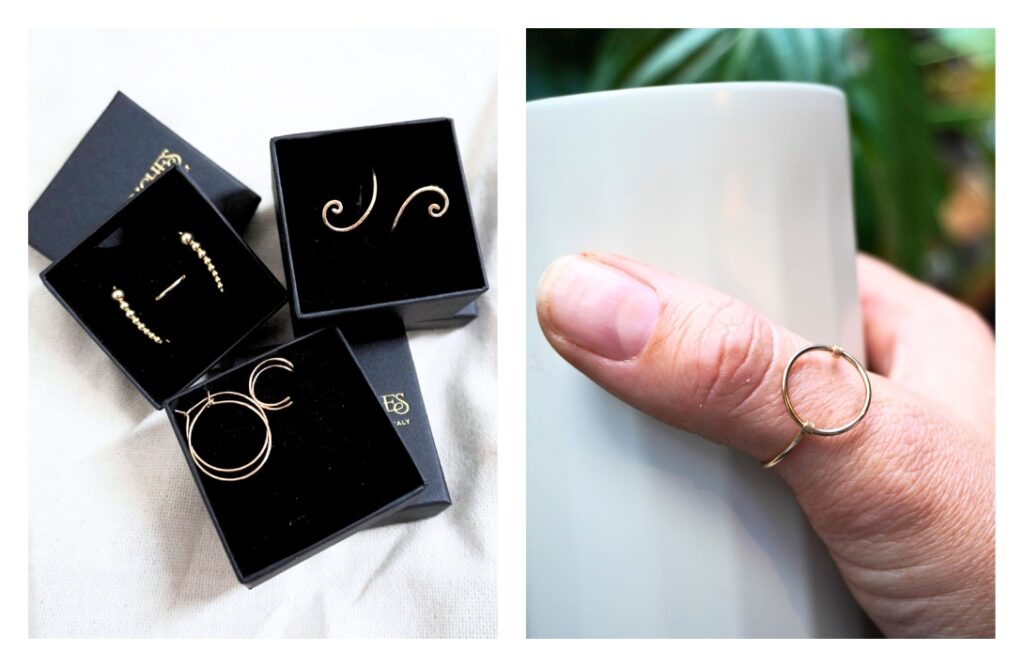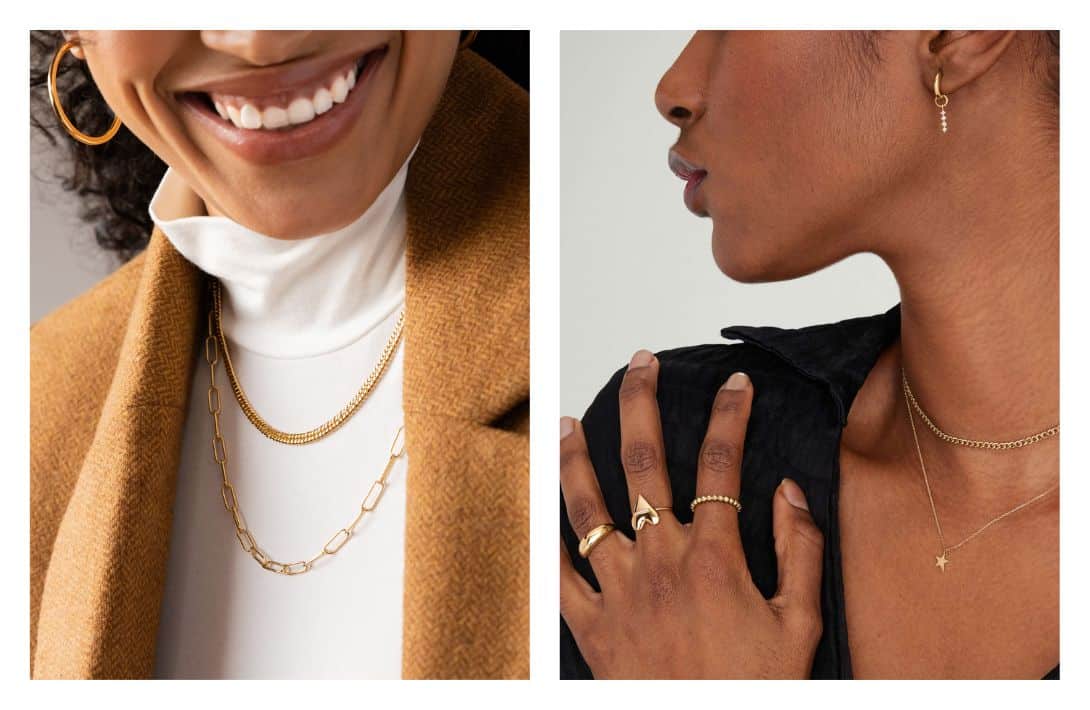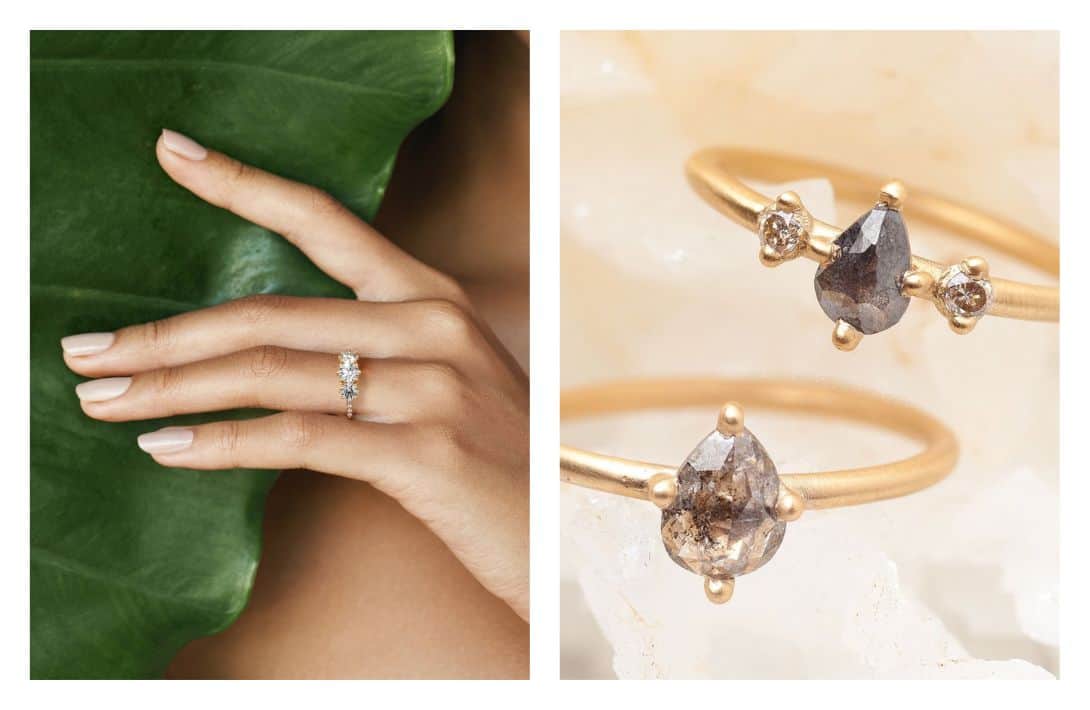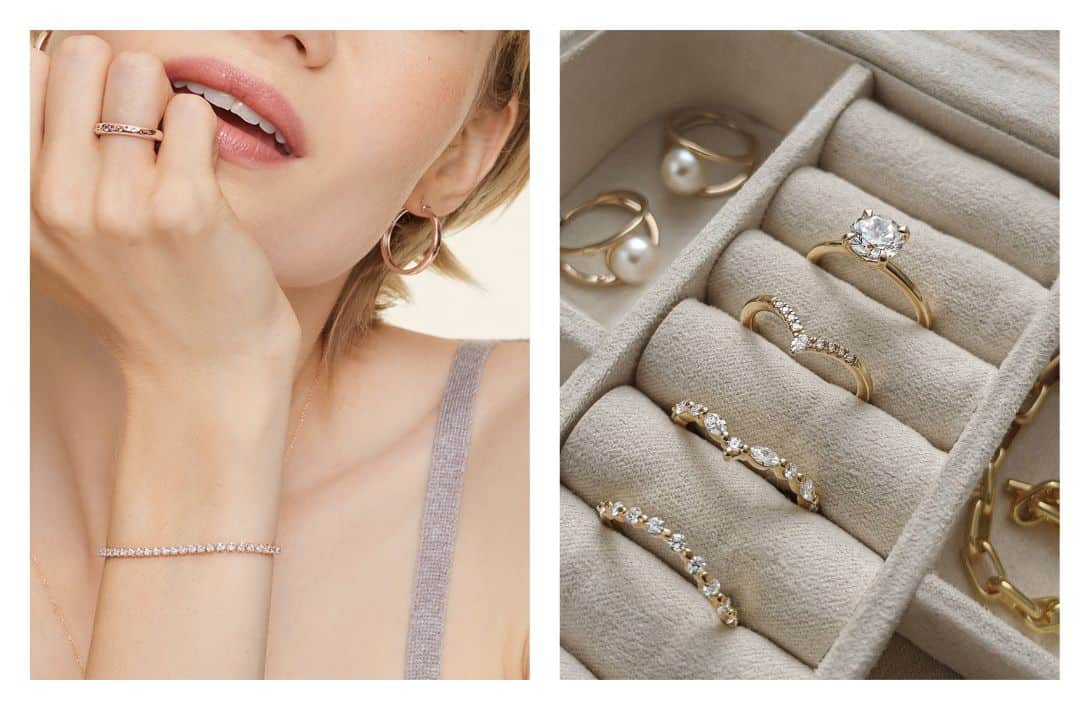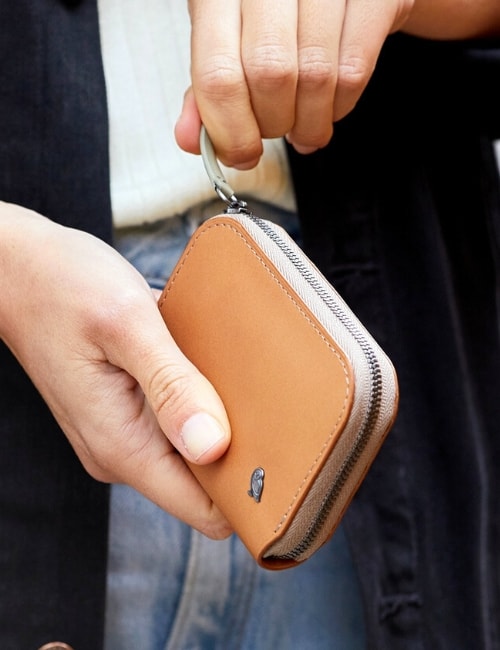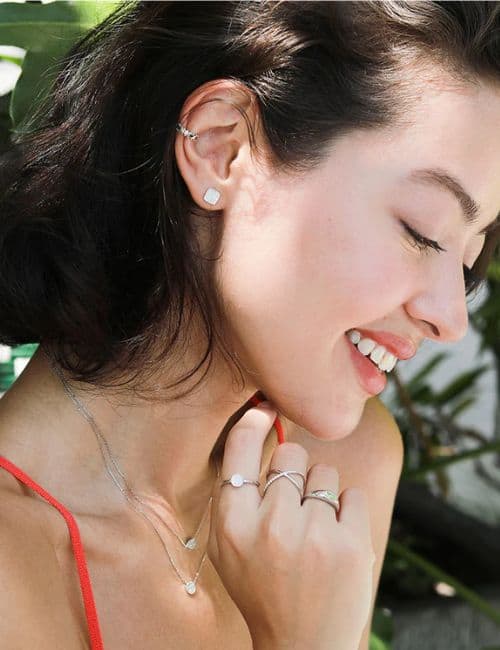11 Conscious Jewelry Brands You Can Covet With A Clearer Conscience
Conscious jewelry—does it really exist?
If you swooned over Leo in Blood Diamond it may have left you feeling pretty discouraged about your favorite accessories of adornment.
There are undoubtedly a lot of blemishes in the jewelry industry, diamond mining being just one of them.
But some socially conscious jewelry brands are catching ethical and eco-minded eyes by refining more than precious metals, jewels, and diamonds.
Everything we recommend to you on Sustainable Jungle is independently researched and we ask all brands to confirm their claims. To avoid waste, we test products on an as needed basis. This post contains affiliate links. If you buy something through our links, we may earn a small commission. Learn more about why we do this here.
Our Top Socially Conscious Jewelry Brands That Dazzle
SOKO‘s fair trade conscious jewelry from Kenya is actively paving ways for artisans to break out of cycles of poverty by selling their unique designs.
Italy-based Rays & Riches transforms ethical metals and upcycled gemstones into earthy, eco-conscious jewelry.
Mejuri takes jewelry brands with a purpose to another level. Their one-of-a-kind pieces support environmental protection and BIPOC communities.
Let’s take a look at other brands that are channeling their inner Rihanna by shining bright like a (conscious) diamond. For more an ear(ring) full on how we chose these quality jewelry brands, jump to the bottom.
The Full List Of Eco-Conscious Jewelry Brands
- SOKO | Visit Store
- Praxis Jewelry | Visit Store
- Rays & Riches | Visit Store
- Mejuri | Visit Store
- Bario Neal | Visit Store
- Astor & Orion | Visit Store
- Catbird | Visit Store
- Valley Rose | Visit Store
- Oscar Massin | Visit Store
- Brilliant Earth | Visit Store
- Pyrrha | Visit Store
1. SOKO
About SOKO
Price Range: $40–$278
Though the craft sector is the second-largest employer in the developing world, millions of artisans become trapped in micro-economies that don’t provide the living wages to support a family.
SOKO wants to change that by connecting consumers directly to marginalized Kenyan artisans.
From chunky dash hoops to dress down with ethical jeans, to glitzy gold statement earrings that will make your dress rental truly pop, their socially conscious jewelry options are suitable for all sustainable styles
SOKO’s Ethical & Sustainability Practices
Materials:
SOKO mostly uses 24k gold-plated brass or chrome, which is made in their Nairobi HQ.
Since almost 90% of brass in the world is recycled brass, it’s a safe bet that a high percentage of theirs is, too.
They also use fair trade beads, horn and bone reclaimed from the food industry, and sustainable teak off-cuts.
Supply chain & labor practices:
The Certified B Corp uses a “virtual factory” to provide livelihood opportunities for Kenyans.
As a result, SOKO artisans earn roughly 5X more than average artisans.
Carbon commitments & green practices:
SOKO is working on their ISO 14001:2015 certification and takes steps to minimize their use of water, energy, hazardous materials, and natural resources.
Community & charitable giving:
Through their SOKO x UNTF collection, purchases of the hand-beaded jewelry supports the United Nations Trust Fund and their efforts to end violence against women.
2. Praxis Jewelry
About Praxis Jewelry
Price Range: $30–$1,594
Praxis Jewelry praxis-ly is practically the forerunner of the conscious jewelry meaning.
Their completely unique and personalized jewelry makes for fabulous eco-friendly gifts. Perhaps some personalized sterling silver stacking rings for the holiday season?
This minimalist jewelry brand’s rings, bracelets, necklaces, and earrings have been featured in stores across the globe, including Anthropologie and Nordstrom.
Praxis Jewelry Ethical & Sustainability Practice
Materials:
Their Earth conscious jewelry features recycled metals (silver and gold) and conflict-free diamonds with SCS Global sustainability certification.
Supply chain & labor practices:
Each piece is handcrafted by owner Allison in her San Diego Studio.
Carbon commitments & green practices:
Eco-friendly recycled materials are incorporated into her designs, naturally meaning a smaller carbon footprint.
Plus, Etsy operates their site using renewable energy and carbon offsets the shipping of all items for their sellers.
3. Rays & Riches
About Rays & Riches
Price Range: $9–$186
Let’s shine a ray of light on brands brand doing it better, like Rays & Riches.
Their collection, featuring designs inspired by organic shapes and cosmic movements, includes items like small spiral rings, rose quartz earrings, and beaded ear climbers. Each piece is a one-of-a-kind creation, often sold only once, which adds an exclusive allure to their offerings.
We personally love donning their eco-conscious jewelry, which features silhouettes of earth’s organic shapes and movements.
For example, small spiral rings that mime the life cycle of plants, rose quartz earrings simulating falling maple seeds, and beaded ear climbers inspired by the cosmos.
All pieces are completely unique, and often only sold once.
Rays & Riches Sustainability & Ethical Practices
Materials:
Most of the hypoallergenic 14k gold filled they use is recycled, though a small percentage comes from Responsible Jewelry Council suppliers.
The rest of their sustainable materials (conscious gems and pearls) are extracted from pre-loved materials, though these gemstone pieces are often extremely limited in run.
Supply chain & labor practices:
Every piece of Earth conscious jewelry is made in Italy by founder Manuela herself.
Pieces are made-to-order, meaning no overproduction, exploitation, or waste.
Green practices & carbon commitments:
Minus the soft inlay in some jewelry boxes, all packaging is 100% biodegradable and recyclable.
The soft plastic-free inlay in each jewelry box is made from tall oil, a cool byproduct of the wood industry. It’s an awesome shift from materials derived from crude oil.
All shipping is 100% carbon offset.
4. Mejuri
About Mejuri
Price Range: $28–$5,900
One of the best high-quality jewelry brands for conscious spenders, Mejuri is a glimmering-good place to turn for everyday fine jewelry.
Their range includes earrings, rings, necklaces, bracelets, wedding jewelry, and conscious jewelry for men.
Not to mention a few hidden gems like this Star Pet Tag (because zero waste dogs and cats deserve the best, too)—plus, the Mini Star Necklace to match.
Mejuri’s Ethical & Sustainability Practices
Materials:
All 14k gold pieces are made with 95% certified recycled and 5% responsibly mined gold. Meanwhile, 92% of their silver products are made with recycled 925 sterling silver.
They also use gold vermeil and titanium, which are finished with responsibly-sourced gemstones, pearls, and enamel.
Supply chain & labor practices:
Is Mejuri ethical?
They do their utmost to try, only working with suppliers who are certified for international ethical standards, like those from the Responsible Jewelry Council.
Though they could be more transparent with their sources, their suppliers must uphold the standards outlined by their Social & Environmental Accountability Program, as well as their Code of Conduct.
Carbon commitments & green practices:
Mejuri is a founding partner of Regeneration, a re-mining initiative dedicated to rehabilitating legacy mine sites and restoring nearby natural environments.
They have a polybag recycling program that collects and ships potential waste to specialized recycling partners.
Part of their climate neutral initiatives involves offsetting carbon through clean and renewable energy credits.
Community & charitable giving:
Via the Salmon Gold initiative from RESOLVE, they have donated over $45,000 to support salmon habitat restoration through gold mining.
Their Empowerment Fund has supported BIPOC women and nonbinary individuals by providing over $324,000 in higher education scholarships.
5. Bario Neal
About Bario Neal NYC
Price Range: $110–$12,760
Through continuous improvement, Bario Neal aims to “create a new sustainable standard within the jewelry industry”.
The woman-owned and run socially conscious jewelry company has a sustainable and socially-conscious sparkle in the form of engagement and wedding rings, custom pieces, earrings, necklaces, bracelets, rings, and wedding bands.
They also offer fine jewelry pieces for an oft-overlooked customer base: babies and children.
Do not look at their delicate gold Keepsake Baby Bangle unless you want to catch zero waste baby fever.
Bario Neal’s Ethical & Sustainability Practices
Materials:
All precious metals are 100% recycled or Fairmined certified.
They also use repurposed or fully traceable colored gemstones, from US mines or those globally that adhere to strict labor and environmental standards.
In addition to using SCS-certified lab created diamonds (which still need a ‘seed’), they use natural white and black ethically-sourced diamonds from Australia, Canada, and Brazil.
Supply chain & labor practices:
Their Fairmined gold comes from artisanal small-scale artisanal mines (ASM) and is refined in the US.
Australian diamonds come from the Argyle Diamond Mine before being finished in Mumbai, Valsad, and Surat under fair and safe working conditions.
Canadian diamonds come from strictly monitored mines in the Northwest Territories.
Carbon commitments & green practices:
Bario Neal’s partner refineries use practices to minimize environmental impacts while recycling the metals.
Their carbon-neutral lab grown diamonds support the Himalayan Climate and Clean Air Project.
Community & charitable giving:
Reflective of their founding belief in marriage equality, inclusivity, comprehensive sizing, and non-gendered design are considered in all pieces.
By supporting ASM mines—of which women are half of the workforce—Bario Neal supports gender equality that helps to strengthen communities.
They also regularly donate to organizations committed to LGBTQIA+ lives, women’s empowerment, and art education.
6. Astor & Orion
About Astor & Orion
Price Range: $45—$240
Seattle-based Astor & Orion is one of the best conscious jewelry brands for balling on a budget.
Their collection of demi-fine jewelry (meaning it’s affordably attainable yet still high-quality) includes earrings and necklaces in a variety of statement-making styles.
Keep it subtle and understated with the Protection Charm Necklaces or “make people stop you on the street to talk about your jewelry” with the signature Dreamer Hoops.
A unique 3D sculpting system transforms the precious metals into creative curves and interlocking geometries, mimicking those found in the natural world.
Astor & Orion’s Ethical & Sustainability Practices
Materials:
Each piece contains a 70% recycled stainless steel cast, plated in either silver or 18k yellow or rose gold.
These platings are at least partially recycled—using gold and silver particles filtered out of the air of their refinery—but we’re not certain of the percentage.
Supply chain & labor practices:
As A&O custom designs and casts the majority of the jewelry and components (closures, ear hooks, etc.) themselves, their supply chain is short and transparent.
Following the ETI Base Code, their SEDEX/SMETA-approved Thailand factory does not use child/forced labor and its ISO 45001 certification ensures the workplace is safe.
Carbon commitments & green practices:
In addition to labor standard certifications, their manufacturing partner holds several environmental certifications: ISO 9001:2015, ISO 14001, Eco Industrial Town Certificate, and Carbon Offset Certificate.
Committed to circularity, production materials are reclaimed and reused, like the air filter which not only makes air safer for workers but recaptures gold and silver dust to be reused.
Their manufacturing partner also filters out pollutants from wastewater.
Through their take-back program, old pieces can be sent back for local recycling, in Seattle courtesy of store credit.
When checking out, add a shipping carbon offset for the sustainable finishing touch.
Community & charitable giving:
Astor & Orion is a member of the Sustainable Fashion Alliance and Fashion Revolution.
7. Catbird
About Catbird
Price Range: $14–$15,500
Artisan jewelry brands and ethically-minded ones don’t always overlap.
But Catbird is bridging both worlds.
The NYC-based brand has rings, earrings, anklets, necklaces, and bracelets for every day (and “the big day”) adornment.
From the Diamond Fizz Necklace for everyday walking around town, to the gorgeous Swan Solitaire Ring for walking to the altar.
Catbird’s Ethical & Sustainability Practices
Materials:
The quality jewelry brand works almost entirely with recycled gold and diamonds for their in-house collections.
Their gold is sourced from vendors that minimize their environmental impact by purchasing a mix of recycled metals and ethically-sourced materials and creating their own alloys.
Both their recycled and lab-grown diamonds adhere to the Kimberley Process.
For the rest of their stones & materials, sourcing is unclear, though they state that their stones are sourced from ethical mines with low environmental impact.
Supply chain & labor practices:
Catbird’s staff receive generous benefits like health insurance, professional development opportunities, retirement plans, and free cold brew coffee.
They are members of No Dirty Gold and the Council of Fashion Designers of America (CFDA).
Carbon commitments & green practices:
Since their in-house line of ethical engagement rings and more is made entirely in Brooklyn, they keep their local footprint to a minimum.
Community & charitable giving:
Through the Catbird Giving Fund, 1% of all sales (over $1 million so far) is donated to equality-promoting non-profits.
8. Valley Rose
About Valley Rose
Price Range: $110-$8,740
Valley Rose is paving the way for alternative and revolutionary jewelry, with ethical necklaces, earrings, and rings (engagement, wedding, and every day).
Their celestial earring collection is truly out of this world!
The ethical earrings mimic the stories of the sky, from these dazzling Orion’s Belt clickers made from conflict-free diamonds.
Valley Rose’s Ethical & Sustainability Practices
Materials:
Their Aether collection is created from one of the rarest, most-cutting edge diamonds in the world. Alchemized from thin air, the lab-grown diamond is crafted using carbon extracted from the atmosphere. The climate-positive conscious gems are positively radiant.
They also utilize 100% Climate Neutral SCS-007 Sustainably Rated lab grown diamonds, salt and pepper diamonds, and recycled diamonds.
Other ethically-sourced gemstones come from small-scale artisanal mines that utilize low-impact mining equipment.
Castings, wires, and chains are 100% Fairmined gold, or, when that isn’t available, recycled gold. Smaller things (like earring backs) may be conventional gold.
Supply chain & labor practices:
Valley Rose is a supporter of Ethical Metalsmiths and ensures everyone in their supply chain is paid fair, liveable wages.
All jewelry is handmade in Sonoma County, California.
Carbon commitments & green practices:
The ethical brand uses PCR paper and compostable materials for all of its packaging, besides their jewelry boxes.
As production volume increases, they are looking for more sustainable alternatives.
Community & charitable giving:
1% of sales are donated to plant trees in North America and the brand regularly supports charities furthering women’s rights, BIPOC rights, animal rights, and environmental protection.
They also donate 1% of sales to Gem Legacy, a nonprofit whose vision is to create thriving colored gemstone mining communities.
9. Oscar Massin
About Oscar Massin
Price Range: $1,000–$14,700
Since the 1800s, Oscar Massin has been producing jewelry fit for royalty.
Now the legend of the Belgian-born “Diamond Reformer” lives on through revolutionary ethical fine jewelry that includes eco- friendly wedding rings, engagement rings, necklaces, bracelets, and earrings.
We could totally see Kate Middleston rocking their luxury 3.76 ctw Souveraine ring.
Oscar Massin’s Ethical & Sustainability Practices
Materials:
Oscar Massin uses Latitude 100% Climate Neutral and fully traceable lab grown diamonds.
Their entire selection is designed in recycled platinum or 18k white, yellow, or rose gold.
Supply chain & labor practices:
SCS certification for their diamonds claims traceability, climate neutrality, sustainable production, adherence to ESG requirements, and investment in local communities.
The jewelry pieces are finished in NYC.
Carbon commitments & green practices:
The jewelry is covered by a two-year warranty and they’re working to reduce the carbon footprint of their operations towards net zero.
10. Brilliant Earth
About Brilliant Earth
Price Range: $75—$79,950
Brilliant Earth is creating a fairer future with our favorite accessories.
Their fine jewelry range includes eco-friendly wedding rings, engagement rings, earrings, necklaces, bracelets, rings, and men’s jewelry.
Their website filters make it easy to shop for only the most conscious jewelry containing recycled and lab grown components, like their stunning 18K White Gold Lab Diamond Tennis Bracelet.
Brilliant Earth’s Ethical & Sustainability Practices
Materials:
Their collections feature 97% recycled silver or 98% recycled gold.
Save their Limited Edition Fairmined Jewelry Collection, which is handcrafted from new responsibly-sourced gold.
Lab-grown diamonds are the root of Brilliant Earth’s jewelry gemstones, some of which are Carbon Neutral.
They also use “beyond conflict-free diamonds” that are tracked through mining, cutting, and polishing all the way to the jeweler via Everledger.
Recycled diamonds are used to a smaller extent.
Supply chain & labor practices:
Brilliant Earth is a member of the Responsible Jewelry Council.
Carbon commitments & green practices:
Partnering with Carbonfund, the Carbonfree®-certified company has offset emissions from its packaging, shipping, energy use, employee travel, and commuting.
They also use FSC-certified jewelry boxes and more, which you can read in their sustainability report.
Community & charitable giving:
Through the Brilliant Earth Foundation, more than $1 million has been granted to support Pure Earth in their efforts for mercury-free mining, as well as the rehabilitation of mining sites in Sierra Leone.
Organizations and causes supported through purchases from their Purpose Driven Jewelry Collection include the NAACP Legal Defense Fund, Rainforest Alliance, and crisis intervention services for LGBTQIA+ youth.
11. Pyrrha
About Pyrrha
Price Range: $195–$345
Inspired by antique Victorian-seals, Pyrrha pieces are designed to resonate with individual’s personalities, stories, and symbols of struggles and joy.
Their signature talismans each share a different meaning, from dandelions representing future prosperity in the Seeds Of Success Talisman, to the Nightingale encouraging resilience.
We were given the wonderful opportunity to try our own Talisman and we felt the Struggle and Emerge calling to us.
We love not only the sturdy built and subtle yet statement-making look of the piece, but we love wearing something with an embedded meaning. Anytime we’re having a difficult day, we can simply touch the talisman and remember that we can make it through any struggle stronger.
They incorporate the dazzling pendants into rings, bracelets, lockets, and more.
Pyrrha’s Sustainability and Ethical Practices:
Materials:
Pyrrha is a member of the Responsible Jewelry Council and uses 100% recycled sterling silver, 14k gold, and bronze.
Their signature diamond collection utilizes conflict-free diamonds.
Supply chain & labor practices:
Their handcrafted jewelry is made from start to finish in their certified Zero Carbon Vancouver Studio (one of two of their certified buildings).
As one of only 20 Certified B Corps in the jewelry industry and certified living wage employers, the brand is dedicated to the well-being of their staff.
Carbon commitment & green practices:
In addition to their zero carbon facilities, the entire Butterfly-marked brand is certified carbon-neutral.
The card paper used in their shipping is handmade in Canada from recycled cotton t-shirt scraps, linen, flax straw, and jute. All other printed materials and boxes are made from recycled or FSC certified paper
Community & charitable giving:
As members of 1% For The Planet, this brand shines bright in the philanthropy sector.
Partial proceeds from two of their talismans are donated to nonprofits supporting mental health and $1 for every gift box declined on their website is donated to the Environmental Youth Alliance.
The Pyrrha Scholarship and Pyrrha Indigenous Student Award supports students in need at Vancouver Community College Jewelry Art and Design Program.
Did you know we Have a Newsletter?
We cover the latest in sustainable living, fashion, zero waste, beauty, travel, finance and more…
How We Chose The Best Conscious Jewelry Brands
Among shopping for all kinds of conscious items, jewelry is still one of the most difficult products to get right.
Pronouncements of “responsible,” “ethical,” and “beyond conflict-free” are as flashy as the jewels themselves.
But like cheap rings that leave green circles on fingers, greenwashing is cheapening the ethical jewelry movement.
What exactly does all of this mean—what is conscious jewelry really?
To answer that, we referred to our sustainable and ethical jewelry criteria:
Materials:
We love lab grown diamonds because they avoid the ethically cringy diamond mining industry altogether (though some do require a natural diamond “seed” to start the process).
Even more so since “conflict-free” stones are difficult to prove— doing so may pull the rug out from underneath other metal and gemstone sourcing issues, like child labor, hazardous working conditions, exploitative pay, and more.
SCS-certified lab created diamonds are best, as this also means they’re carbon-neutral
Recycled diamonds and gemstones are another alternative to avoid mines altogether. Though very likely not traceable, a recycled diamond is at least not leading to further damage.
Gold has its fair share of ethical and environmental concerns, too.
Fairtrade and Fairmined Gold is a step in the right direction, but even it has its shortcomings— there are zero Fairmined/Fairtrade certified mines on the entire continent of Africa where a lot of gold is mined.
Here, too, we think recycled is best.
As for other conscious gems (sapphires, pearls), the more brands can share about where/how they were sourced, the better.
- Certifications: The Kimberley Process, SCS Global, Fair Gold, and Fairmined Gold
Supply chain & labor practices:
“Conflict-free” only scratches the surface of conscious jewelry.
Fair pay, support for communities, and practices to limit working hours or prevent child/forced labor should be prioritized, too.
- Certifications: ISO 9001, Sedex Members Ethical Trade Audit (SMETA), International Organization for Standardization (ISO 9001), ISO 14001, ISO 45001, Ethical Trading Initiative (ETI), B Corporation (B Corp)
Carbon commitments & green practices:
Some of these sustainable jewelry brands prove that it’s possible to create breathtaking pieces while using practices that filter air, so it won’t harm workers.
They’re also doing their part to reduce their impact through carbon offset programs, eco-packaging, wastewater treatment, and turning manufacturing waste back into bling.
Community & charitable giving:
When a new pair of diamond studs also means a new pair of spruce trees or donations to an environmental or socially-oriented organization, they’ll sparkle even more.
Closing Thoughts On Quality Conscious Jewelry
Before you click “buy now” or sign on the dotted line, have you considered vintage options from second hand stores?
The most Earth conscious jewelry is often also the pre-loved type.
If you’ve searched the racks and can’t quite find that diamond in the rough, move on to these conscious jewelry brands that are setting the stage for a more conscious industry.
While you’re at it, share this article, so we can spread awareness and promote bling that truly shines (for everyone involved).
Pin these:
